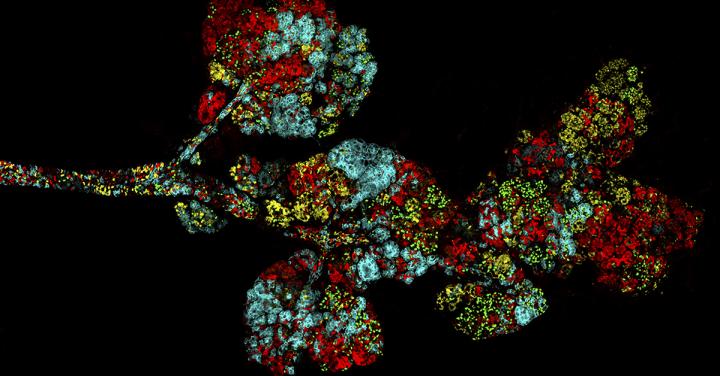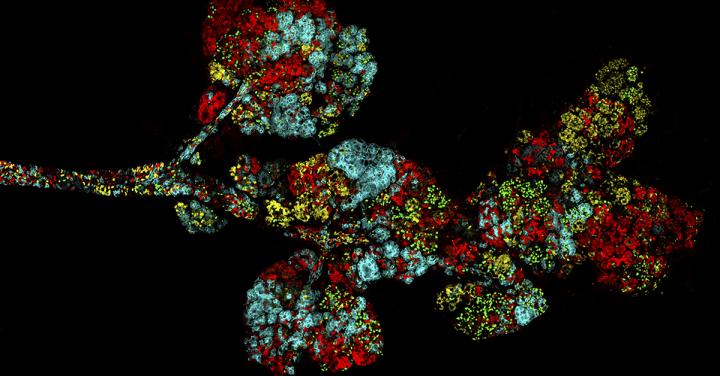
Credit: Dr Anne Rios, Walter and Eliza Hall Institute
Walter and Eliza Hall Institute researchers have used advanced cellular, bioinformatics and imaging technology to reveal a long-lived type of stem cell in the breast that is responsible for the growth of the mammary glands during pregnancy.
The newly discovered stem cells, which respond to the 'ovarian hormones' progesterone and oestrogen, may also be linked to a high-risk form of breast cancer.
The discovery was made by Dr Nai Yang Fu, Dr Anne Rios, Professor Jane Visvader and Professor Geoff Lindeman as part of a 20-year research program into how the breast develops from stem cells, and how breast cancers can arise from stem cells and developing breast tissue. The research was published today in Nature Cell Biology.
Dr Fu said the team had been able to build on their earlier discovery of breast stem cells, by defining subsets of stem cells with different functions, a project that was conducted in collaboration with bioinformatics researchers Dr Matthew Ritchie and Professor Gordon Smyth.
"When we looked at the genes that were switched on in these stem cells, we could distinguish subsets of stem cells that differed in their expression of genes encoding two proteins called Tetraspanin8 and Lgr5," he said. "By looking at the levels of Tetraspanin8 and Lgr5 protein on the surface of the cells, we could divide the stem cells into three separate groups."
The team used advanced technologies including three-dimensional imaging to show that the three groups of stem cells are located in different parts of the breast and function differently, Dr Rios said.
"We focused particularly on one stem cell subtype that had the highest levels of Tetraspanin8 and Lgr5 protein, which were located in the 'proximal' region of the breast around the nipple," Dr Rios said.
Professor Visvader said these stem cells were normally dormant – sitting quietly and not dividing – and remained in the proximal region throughout life. "However, when they were exposed to the hormones progesterone and oestrogen these cells awakened and could rapidly give rise to new breast cells," she said.
The research also revealed that the stem cells with high levels of Tetraspanin8 and Lgr5 protein had many similarities to a subtype of 'triple negative' breast cancers known as claudin-low cancers.
"Compared to other types of breast cancer, claudin-low cancers have a high chance of recurrence after treatment, leading to a poor prognosis for patients" Professor Visvader said.
Professor Lindeman, who is also a medical oncologist at the Peter MacCallum Cancer Centre and The Royal Melbourne Hospital, said the research may lead to future improved outcomes for people with claudin-low cancers, "We hope that our discovery can be used to understand how cancers may arise from long-lived stem cells, and potentially lead to better outcomes for breast cancer patients in the future," he said.
###
The research was supported by the National Health and Medical Research Council, the Australian Cancer Research Foundation, The Qualtrough Cancer Research Fund, the Joan Marshall Breast Cancer Research Fund, the National Breast Cancer Foundation, Cure Cancer Australia, the Victorian Cancer Agency and the Victorian Government Operational Infrastructure Support Scheme.
The Walter and Eliza Hall Institute is the research powerhouse of the Victorian Comprehensive Cancer Centre, an alliance of leading Victorian hospitals and research centres committed to controlling cancer.
Media Contact
Vanessa S Solomon
[email protected]
61-431-766-715
@WEHI_research
############
Story Source: Materials provided by Scienmag





